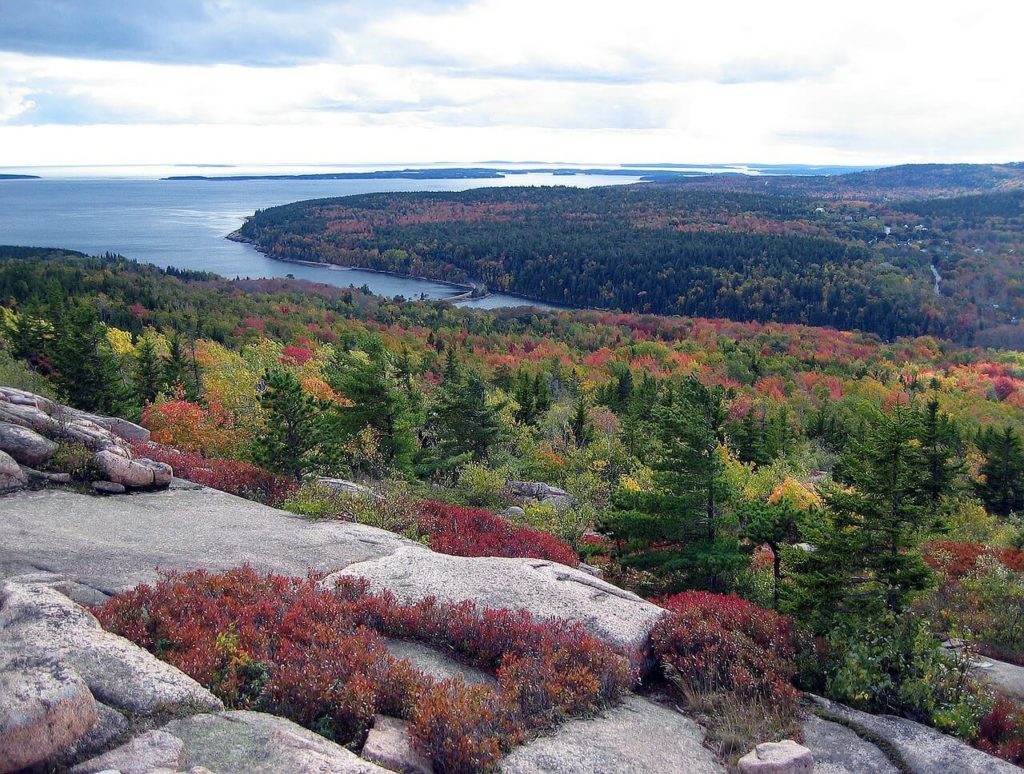Table of Contents
Overview / About the Park
Acadia National Park lies on the rugged coast of Maine, where mountains rise straight from the Atlantic Ocean. Spread across Mount Desert Island, parts of Isle au Haut, and the Schoodic Peninsula, it’s known for its granite peaks, rocky shores, and old forests.
This was the first national park established east of the Mississippi River. It’s small but breathtaking, a mix of ocean, forest, and mountain views in one compact landscape.

Wildlife & Nature
Acadia’s ecosystem blends coastal and northern forest habitats. You’ll find white-tailed deer, red foxes, porcupines, and sometimes harbor seals near the coast. Birdwatchers come for peregrine falcons, bald eagles, and seabirds that nest on the cliffs. In autumn, the park’s hardwood forests blaze with orange, red, and gold, one of the best fall color displays in the U.S.
Experiences & Activities
- Hiking: Acadia has over 150 miles of trails. Favorites include Jordan Pond Path, Beehive Trail, and Cadillac Mountain Summit Trail.
- Scenic Drives: The Park Loop Road offers classic ocean views and easy access to key spots like Thunder Hole and Sand Beach.
- Biking: The park’s historic carriage roads are ideal for cycling through quiet forest and granite bridges.
- Kayaking & Wildlife Watching: Paddle along the coastline or watch the sunrise from Cadillac Mountain, one of the first places in the U.S. to see daylight.
Best Time to Visit
The park is open year-round, but the best time to visit is late spring to fall (May–October).
- Summer: Warm, active, and ideal for hiking and kayaking.
- Autumn: Crisp weather and famous foliage.
- Winter: Quieter, with snowshoeing and cross-country skiing on the carriage roads.
How to Reach & Park Entry
- Nearest airport: Hancock County–Bar Harbor Airport (BHB), about 10 miles from the park entrance. Bangor International Airport (BGR) is 50 miles away.
- From Boston, it’s roughly a 5-hour drive (280 miles).
- Entry fee: $35 per vehicle, valid for seven days. An annual Acadia Pass is also available.
Where to Stay / Camping Options
Inside the park, the main campgrounds are Blackwoods, Seawall, and Schoodic Woods, each surrounded by forest and close to trails.
Nearby Bar Harbor offers inns, lodges, and family-run B&Bs with easy park access. Booking ahead is important in summer.
Travel Tips / Safety Notes
- Weather can shift quickly, bring layers even in summer.
- Drive carefully on narrow mountain roads, especially around Cadillac Mountain.
- Keep food sealed to avoid attracting wildlife.
- Cell service is patchy in some areas; download maps in advance.
- Start hikes early to avoid crowds on popular trails.
Packing List
- Comfortable hiking shoes or boots
- Rain jacket and warm layers
- Reusable water bottle and snacks
- Camera or binoculars for wildlife
- Sunscreen, hat, and insect repellent
- Map or GPS (offline version)
- Flashlight or headlamp for early sunrise hikes
Visitor Statistics
Acadia National Park welcomes around 3.9 to 4 million visitors each year, making it one of the top 10 most visited U.S. national parks.
Peak season is July through September, while May, early June, and late October are quieter but still beautiful.
Conservation & Responsible Tourism
Acadia faces challenges like erosion, climate change, and heavy visitation. The park’s management works on trail restoration, wildlife monitoring, and coastal protection projects.
Visitors can help by sticking to marked trails, avoiding trampling vegetation, and using the free Island Explorer shuttle to cut down on car traffic.












